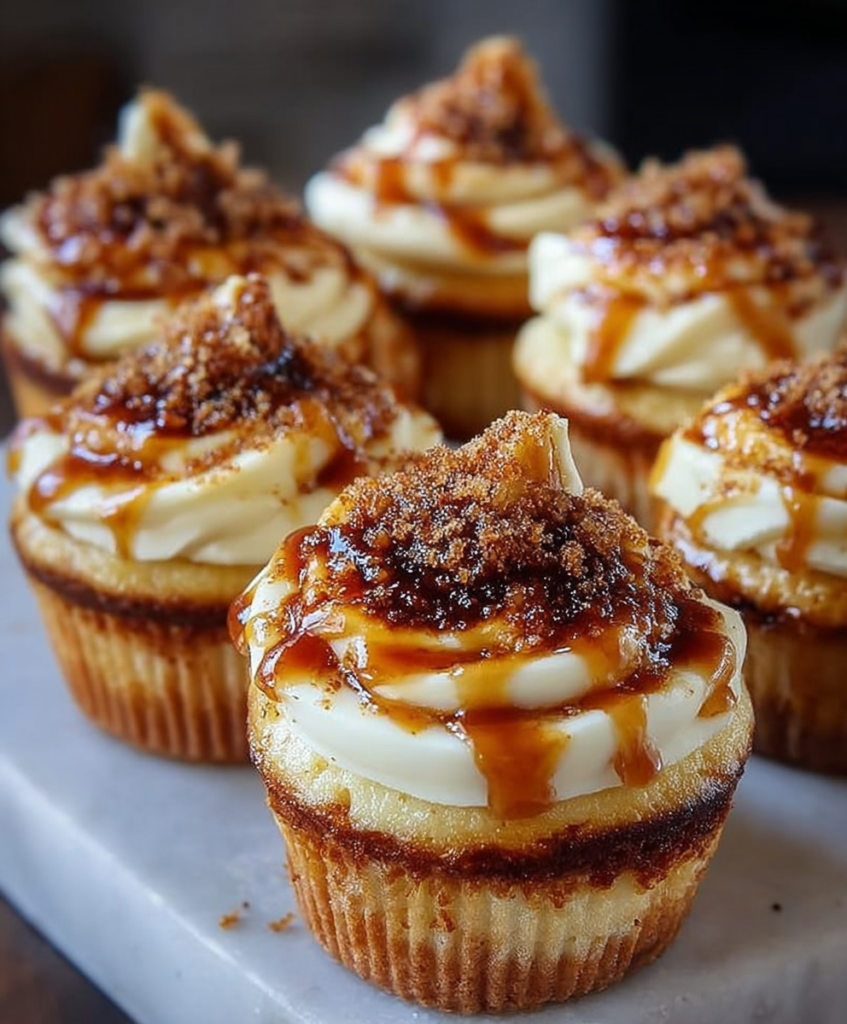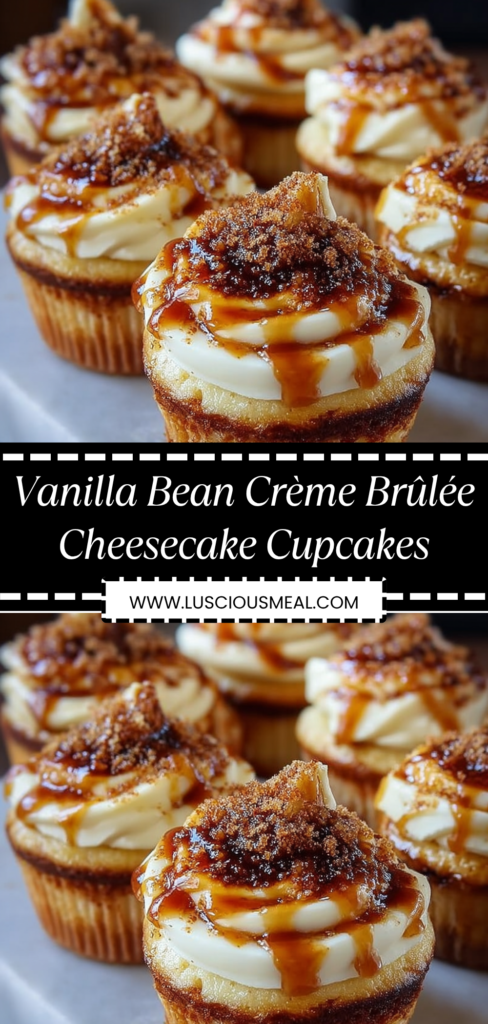
These are the cupcakes that break all the rules—individual cheesecakes infused with real vanilla bean, topped with the signature crack of caramelized sugar that shatters under your spoon to reveal silky smooth custard beneath. They’re what happens when New York cheesecake meets French crème brûlée in perfect, portion-controlled packages that eliminate the stress of slicing while maximizing that coveted crispy sugar-to-creamy filling ratio. One tap of the spoon through that glassy amber top and you’ll understand why these aren’t just desserts—they’re edible jewelry.
Ingredients
For the Graham Cracker Crust:
- 1½ cups graham cracker crumbs (about 10 full crackers)
- ¼ cup granulated sugar
- 6 tablespoons unsalted butter, melted
- ¼ teaspoon salt
- ½ teaspoon cinnamon
For the Cheesecake Filling:
- 24 ounces cream cheese (3 packages), room temperature
- ¾ cup granulated sugar
- 3 large eggs, room temperature
- ½ cup sour cream, room temperature
- ¼ cup heavy cream
- 2 vanilla bean pods, split and scraped
- 1 tablespoon vanilla extract
- 2 tablespoons all-purpose flour
- ¼ teaspoon salt
For the Vanilla Bean Custard Layer:
- 1 cup heavy cream
- 4 large egg yolks
- ¼ cup granulated sugar
- 1 vanilla bean pod, split and scraped
- Pinch of salt
For the Brûlée Topping:
- ½ cup granulated sugar (about 2 teaspoons per cupcake)
- Kitchen torch (essential)
Equipment Needed:
- 12-cup muffin tin
- Paper cupcake liners
- Kitchen torch
- Fine-mesh strainer
- Small offset spatula
Instructions
- Prepare Crusts: Preheat oven to 325°F. Line muffin tin with paper liners. Mix graham cracker crumbs, sugar, melted butter, salt, and cinnamon until evenly moistened. Press 2 tablespoons mixture firmly into bottom of each liner. Bake 5 minutes until set. Cool while preparing filling.
- Make Cheesecake Base: Beat room temperature cream cheese until completely smooth and fluffy, about 3 minutes. Scrape bowl frequently—lumps now mean lumps forever. Add sugar and beat until dissolved, another 2 minutes.
- Incorporate Eggs: Add eggs one at a time, beating on low just until combined after each. Overmixing incorporates air that causes cracks. Mix in sour cream, heavy cream, vanilla bean seeds, vanilla extract, flour, and salt until just combined.
- Fill and Bake: Divide batter among crusts, filling about ¾ full (about 3 tablespoons each). Tap pan gently to release bubbles. Bake 18-22 minutes until edges are set but centers jiggle slightly when tapped.
- Cool Gradually: Turn off oven, crack door open, let cool in oven 30 minutes. This gradual cooling prevents cracks. Remove and cool completely at room temperature, then refrigerate at least 4 hours or overnight.
- Make Custard Layer: Heat cream with vanilla bean pod and seeds in saucepan until just steaming. Whisk egg yolks and sugar until pale. Temper by slowly adding hot cream while whisking. Return to pan, cook stirring constantly until it coats spoon (170°F).
- Strain and Cool: Strain custard through fine-mesh sieve to remove lumps and vanilla pod. Cool 10 minutes, stirring occasionally to prevent skin forming. Custard should be pourable but not hot.
- Add Custard Layer: Remove cheesecakes from refrigerator. Gently spoon 1-2 tablespoons custard over each, creating thin even layer. Return to refrigerator for at least 2 hours until custard sets.
- The Brûlée Moment: Just before serving, remove paper liners carefully. Sprinkle each with 2 teaspoons sugar, tilting to create even layer. Torch sugar until deep amber and bubbling. Let cool 1 minute for sugar to harden.
- Serve Immediately: The sugar crust softens quickly, so serve within 30 minutes of torching for optimal crack. Provide small spoons for that satisfying first crack through the caramelized top.
Recipe Notes
- Prep Time: 45 minutes
- Bake Time: 22 minutes
- Chilling Time: 6+ hours total
- Total Time: 7 hours
- Yield: 12 cupcakes
- Calories: 385 per cupcake
The Art of Three Textures
These cupcakes achieve what seems impossible—three distinct textures in one elegant package. The graham crust provides sweet, sandy crunch that grounds each bite. The cheesecake layer delivers rich, dense creaminess that defines New York style. The custard adds silky smoothness that bridges to the crispy brûlée top. Each component maintains its identity while creating harmonious bites.
The genius lies in the proportions. Traditional crème brûlée can be one-note smooth; regular cheesecake sometimes monotonously dense. By combining both with precise ratios, we create textural variety that keeps palates engaged. That thin custard layer isn’t just garnish—it provides the authentic crème brûlée experience while preventing the sugar from making the cheesecake soggy.
Temperature differentials during serving add another dimension. The cold cheesecake contrasts with room-temperature sugar crust, creating thermal interest beyond just textural. This temperature play is part of crème brûlée’s appeal—maintaining it in cupcake form required careful engineering of components and timing.
Vanilla Bean Mastery
Using real vanilla beans transforms these from excellent to extraordinary. The tiny black seeds distribute throughout both cheesecake and custard, providing visual proof of quality while delivering incomparable flavor. Vanilla extract alone can’t replicate the complex floral notes and aromatic intensity of fresh beans.
Proper bean usage maximizes value from these expensive pods. Split lengthwise with sharp knife, scrape seeds with knife’s back. The seeds tend to clump—whisk into small amount of liquid first for even distribution. Save scraped pods for vanilla sugar by burying in granulated sugar for two weeks.
The combination of beans AND extract isn’t redundancy—it’s flavor layering. Beans provide intense bursts and visual appeal, while extract ensures even background flavor throughout. Using both creates depth impossible with either alone. For economy, use all extract, but expect less complex flavor.

Cheesecake Science
Room temperature ingredients are non-negotiable for smooth cheesecake. Cold cream cheese won’t beat smooth regardless of mixing time. Cold eggs don’t incorporate properly. Set ingredients out 2-3 hours before starting, or use quick tricks: cube cream cheese for faster warming, place eggs in warm water 10 minutes.
That flour addition might seem unusual for cheesecake, but it serves important purpose. The small amount helps prevent cracks by providing structure that accommodates expansion and contraction during baking and cooling. It also creates slightly firmer texture that supports the custard layer without compromising creaminess.
Minimal mixing after adding eggs prevents incorporating excess air. Air bubbles expand during baking then collapse during cooling, causing cracks and uneven texture. Mix just until ingredients combine—perfection comes from technique, not vigorous beating. Those few lumps will bake out.
The Custard Bridge
The custard layer transforms good cheesecake cupcakes into crème brûlée perfection. This isn’t pastry cream or pudding—it’s true crème anglaise that sets just enough to support sugar but remains silky. The technique requires patience but delivers professional results.
Tempering prevents scrambled eggs in your custard. That slow stream of hot cream while whisking constantly gradually raises egg temperature without cooking. Return to gentle heat and stir constantly—the moment it coats a spoon, remove from heat. Overcooking creates grainy texture unsalvageable by straining.
Straining removes any lumps plus the vanilla pod, ensuring silk-smooth results. The 10-minute cooling with occasional stirring prevents skin formation while bringing temperature down enough to not melt cheesecake. Too hot and it won’t set properly; too cool and it won’t self-level.
Brûlée Technique and Timing
The signature sugar crust requires proper technique for that satisfying crack. Even layer thickness ensures uniform caramelization—thick spots burn before thin areas caramelize. That gentle tilt-and-tap method distributes sugar better than spoon spreading.
Torch technique separates amateur from professional results. Keep flame moving constantly to prevent burnt spots. The sugar should bubble and turn deep amber—pale won’t crack properly, too dark tastes bitter. Distance matters: 2-3 inches gives control without overheating custard beneath.
Timing is everything with brûlée topping. Sugar crust begins softening from custard moisture within 30 minutes. For parties, torch in batches as needed rather than all at once. The theatrical element of tableside torching adds excitement—guests love watching sugar transform to glass.
Troubleshooting Common Issues
“Cheesecakes cracked”: Overbeating, temperature shock, or overbaking. Mix minimally, cool gradually, and remove while centers still jiggle slightly.
“Custard didn’t set”: Undercooked or wrong proportions. Must reach 170°F for proper thickening. Use thermometer for accuracy.
“Sugar won’t caramelize evenly”: Moisture on surface or uneven layer. Ensure custard is cold and dry, distribute sugar carefully.
“Crusts are soggy”: Underbaked initially or custard too hot when added. Ensure crust is golden and custard is cooled.
“Can’t remove paper liners”: Cheesecake too warm or liners not sprayed. Chill thoroughly and use cooking spray on liners before filling.
Make-Ahead Strategies
These cupcakes are perfect for entertaining because most work happens in advance. Cheesecakes can be made 3 days ahead, stored covered in refrigerator. Add custard layer day before serving. Only the brûlée topping must be done last minute.
For larger parties, set up brûlée station: sugar in small bowl, torch at ready, spoons for serving. Designate someone for torching while others serve. The active preparation becomes entertainment, filling room with caramelized sugar aroma.
Individual components freeze well separately. Cheesecakes freeze up to month without custard layer. Thaw overnight in refrigerator, add custard and brûlée fresh. This allows make-ahead for special occasions without quality sacrifice.
Flavor Variations
Chocolate Crème Brûlée: Add 4 ounces melted dark chocolate to cheesecake. Use chocolate graham crackers for crust.
Citrus Twist: Replace vanilla with lemon or orange zest in both layers. Particularly elegant with Meyer lemon.
Coffee Lovers: Infuse cream with espresso beans for custard. Add instant espresso to cheesecake.
Berry Beautiful: Layer fresh berry compote between cheesecake and custard. Raspberry or passion fruit excel.
Salted Caramel: Add salted caramel to cheesecake, finish with fleur de sel on brûlée.
Serving and Presentation
Remove paper liners just before brûléeing for cleanest presentation. The naked sides showcase distinct layers beautifully. Place on individual plates with small spoons—forks don’t crack sugar properly.
Garnish simply to not distract from the star. Single fresh raspberry, mint leaf, or edible flower adds color. Dust plate edge with vanilla sugar for aromatic enhancement. Tiny pitcher of extra custard allows customization.
Temperature contrast enhances enjoyment. Serve immediately after torching while sugar is crisp and interior cold. The thermal variation adds dimension beyond flavor and texture. Provide napkins—the first crack often sends sugar shards flying.
Cost Analysis
While ingredients seem expensive—vanilla beans, cream cheese, heavy cream—the per-serving cost remains reasonable. Twelve restaurant-quality individual desserts for under $20 total rivals any bakery pricing. The wow factor delivered far exceeds investment.
Vanilla beans represent the largest expense but provide incomparable results. Buy in bulk online for significant savings. Properly stored in airtight container, they last months. The flavor impact justifies cost for special occasions.
The Show-Stopping Factor
These cupcakes deliver restaurant dramatics in home setting. The torch action provides dinner party entertainment. That first spoon crack creates anticipation. The layered reveal when cut showcases technique. It’s dessert as performance art.
Beyond visual impact, the flavor complexity impresses sophisticated palates. The vanilla intensity, textural variety, and temperature contrasts create memorable experiences. Guests request recipes and remember these long after ordinary desserts fade.
Final Thoughts
These Vanilla Bean Crème Brûlée Cheesecake Cupcakes represent the pinnacle of dessert fusion—taking the best elements of two classics and creating something transcendent. They prove that innovation doesn’t mean abandoning tradition but rather respecting what makes each component special while imagining new possibilities. The combination of creamy cheesecake, silky custard, and that glorious caramelized sugar creates an experience that engages all senses. Master these and you’ll possess a signature dessert that generates genuine amazement, proving that sometimes the best recipes come from refusing to choose between two favorites and deciding to have both.